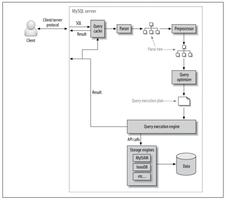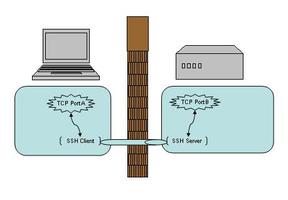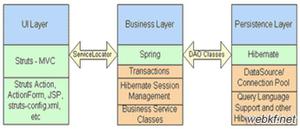通过JSch的SSH隧道
我的目的是连接到位于防火墙后面的服务器(主机)。我可以通过连接到网络中的另一台服务器(隧道)然后通过SSH到该服务器来访问此服务器。但是,我无法通过JSch实现相同的方案。
我无法为此编写以下代码。如果我在这里做任何愚蠢的事情,请告诉我。
public class JschExecutor { public static void main(String[] args){
JschExecutor t=new JschExecutor();
try{
t.go();
} catch(Exception ex){
ex.printStackTrace();
}
}
public void go() throws Exception{
StringBuilder outputBuffer = new StringBuilder();
String host="xxx.xxx.xxx.xxx"; // The host to be connected finally
String user="user";
String password="passwrd";
int port=22;
String tunnelRemoteHost="xx.xx.xx.xx"; // The host from where the tunnel is created
JSch jsch=new JSch();
Session session=jsch.getSession(user, host, port);
session.setPassword(password);
localUserInfo lui=new localUserInfo();
session.setUserInfo(lui);
session.setConfig("StrictHostKeyChecking", "no");
ProxySOCKS5 proxyTunnel = new ProxySOCKS5(tunnelRemoteHost, 22);
proxyTunnel.setUserPasswd(user, password);
session.setProxy(proxyTunnel);
session.connect(30000);
Channel channel=session.openChannel("exec");
((ChannelExec)channel).setCommand("hostname");
channel.setInputStream(null);
((ChannelExec)channel).setErrStream(System.err);
InputStream in=channel.getInputStream();
BufferedReader ebr = new BufferedReader(new InputStreamReader(in));
channel.connect();
while (true) {
byte[] tmpArray=new byte[1024];
while(in.available()>0){
int i=in.read(tmpArray, 0, 1024);
if(i<0)break;
outputBuffer.append(new String(tmpArray, 0, i)).append("\n");
}
if(channel.isClosed()){
System.out.println("exit-status: "+channel.getExitStatus());
break;
}
}
ebr.close();
channel.disconnect();
session.disconnect();
System.out.println(outputBuffer.toString());
}
class localUserInfo implements UserInfo{
String passwd;
public String getPassword(){ return passwd; }
public boolean promptYesNo(String str){return true;}
public String getPassphrase(){ return null; }
public boolean promptPassphrase(String message){return true; }
public boolean promptPassword(String message){return true;}
public void showMessage(String message){}
}
}
上面的代码session.connect(30000);在行中给出了以下异常。
com.jcraft.jsch.JSchException: ProxySOCKS5: com.jcraft.jsch.JSchException: fail in SOCKS5 proxy at com.jcraft.jsch.ProxySOCKS5.connect(ProxySOCKS5.java:317)
at com.jcraft.jsch.Session.connect(Session.java:231)
at com.ukris.main.JschExecutor.go(JschExecutor.java:50)
at com.ukris.main.JschExecutor.main(JschExecutor.java:19)
Caused by: com.jcraft.jsch.JSchException: fail in SOCKS5 proxy
at com.jcraft.jsch.ProxySOCKS5.connect(ProxySOCKS5.java:200)
... 3 more
回答:
SOCKSjsch上的代理设置允许您连接到远程端上 正在运行的 代理服务器。一个sshd在远程端将
被视为一个SOCKS代理。您需要做的是建立一个本地端口,该本地端口转发到您要隧道连接到的计算机上的ssh端口,然后使用api建立与此系统的辅助ssh连接。
我以您的示例为例,并对其进行了略微重写以实现此目的:
import com.jcraft.jsch.*;import java.io.*;
public class JschExecutor2 {
public static void main(String[] args){
JschExecutor2 t=new JschExecutor2();
try{
t.go();
} catch(Exception ex){
ex.printStackTrace();
}
}
public void go() throws Exception{
StringBuilder outputBuffer = new StringBuilder();
String host="firstsystem"; // First level target
String user="username";
String password="firstlevelpassword";
String tunnelRemoteHost="secondlevelhost"; // The host of the second target
String secondPassword="targetsystempassword";
int port=22;
JSch jsch=new JSch();
Session session=jsch.getSession(user, host, port);
session.setPassword(password);
localUserInfo lui=new localUserInfo();
session.setUserInfo(lui);
session.setConfig("StrictHostKeyChecking", "no");
// create port from 2233 on local system to port 22 on tunnelRemoteHost
session.setPortForwardingL(2233, tunnelRemoteHost, 22);
session.connect();
session.openChannel("direct-tcpip");
// create a session connected to port 2233 on the local host.
Session secondSession = jsch.getSession(user, "localhost", 2233);
secondSession.setPassword(secondPassword);
secondSession.setUserInfo(lui);
secondSession.setConfig("StrictHostKeyChecking", "no");
secondSession.connect(); // now we're connected to the secondary system
Channel channel=secondSession.openChannel("exec");
((ChannelExec)channel).setCommand("hostname");
channel.setInputStream(null);
InputStream stdout=channel.getInputStream();
channel.connect();
while (true) {
byte[] tmpArray=new byte[1024];
while(stdout.available() > 0){
int i=stdout.read(tmpArray, 0, 1024);
if(i<0)break;
outputBuffer.append(new String(tmpArray, 0, i));
}
if(channel.isClosed()){
System.out.println("exit-status: "+channel.getExitStatus());
break;
}
}
stdout.close();
channel.disconnect();
secondSession.disconnect();
session.disconnect();
System.out.print(outputBuffer.toString());
}
class localUserInfo implements UserInfo{
String passwd;
public String getPassword(){ return passwd; }
public boolean promptYesNo(String str){return true;}
public String getPassphrase(){ return null; }
public boolean promptPassphrase(String message){return true; }
public boolean promptPassword(String message){return true;}
public void showMessage(String message){}
}
}
这段代码的作用是创建一个本地端口,将其转发到目标系统上的ssh端口,然后通过它进行连接。hostname命令的运行表明它确实在转发的系统上运行。
以上是 通过JSch的SSH隧道 的全部内容, 来源链接: utcz.com/qa/419755.html









